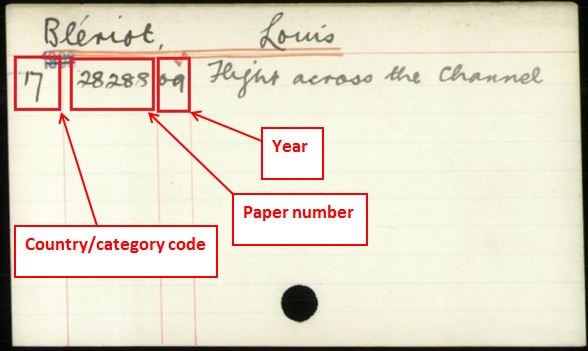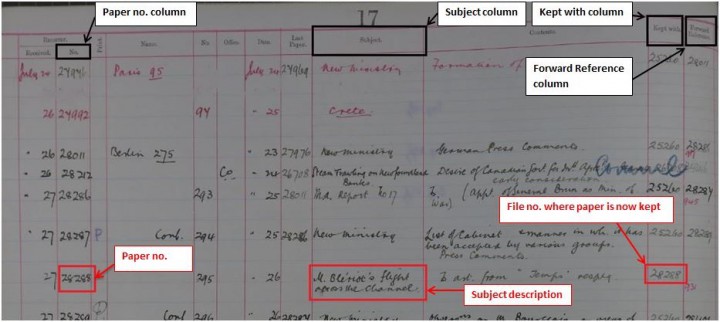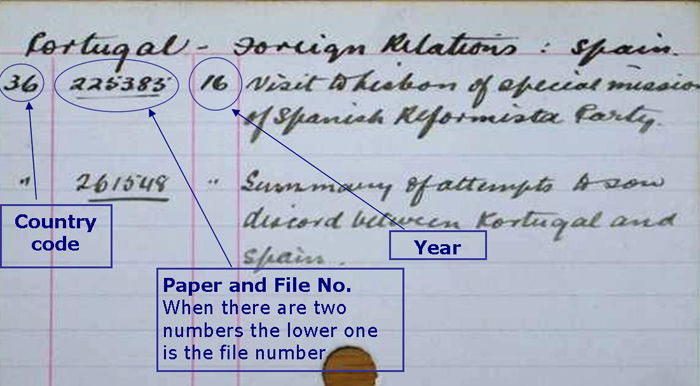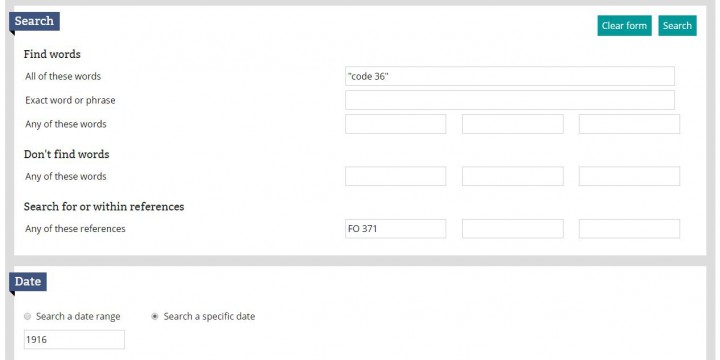
How to look for records of... Foreign Office correspondence 1906-1919
How can I view the records covered in this guide?
How many are online?
- Some
Contents
- 1. Why use this guide?
- 2. The Foreign Office card index
- 3. Searching for correspondence 1906-1910
- 4. Searching for correspondence 1910-1919
- 5. Key to codes on the index cards
- 6. How to find related correspondence 1906-1910
- 7. Other types of Foreign Office correspondence and related records
- 8. Further reading
1. Why use this guide?
Use this guide for advice on how to search for Foreign Office correspondence dating from 1906 to 1919 and now held at The National Archives. In most cases you can search for references to the records online but you will need to visit us to view the correspondence itself. For advice on other types of Foreign Office records see our broader overview guide.
Foreign Office correspondence is a rich source of information on the history of British relations with foreign states and can also provide insights into past domestic issues in countries around the world.
2. The Foreign Office card index
Correspondence received by the Foreign Office was numbered and categorised. The numbers and categories were recorded on small cards and these cards served as the index to the correspondence.
This Foreign Office card index is still used today, at The National Archives, to identify correspondence relevant to a particular country, person or subject area. Nowadays, however, the index is accessed online, in the downloadable record series FO 1111. Each category also has a corresponding National Archives’ record series (see the table in Section 3.2).
In 1910 the Foreign Office changed its registry system, making the search method for 1906-1909 slightly different to the method for 1911-1919. For 1910 itself you may need to try both methods.
Not all the correspondence to which the index refers was sent for preservation to The National Archives so today some index entries refer to documents which no longer exist.
3. Searching for correspondence 1906-1910
For 1906-1909 (and part of 1910) you will first need to use the card index and then the general registers of correspondence before you can identify an individual piece of correspondence. Unlike the index, the registers have not been digitised and therefore you cannot view them online. To view them you will need to visit The National Archives.
Follow these steps to find correspondence:
Step 1: Identify a section of the index to download from our catalogue
- Use the FO 1111 series search in our catalogue to search by year only.
- Sort your results by reference – this will put them into alphabetical (as well as reference) order.
- Look for the letter (or alphabetical range) that covers your subject, name or place of interest. You may have to do some lateral thinking to find your way around the terms used for subjects in the index – you will often have to guess at how the Foreign Office would have originally categorised a subject. You may, therefore, need to download multiple sections of the index.
- Download your selected section of the index.
Step 2: Identify a card index entry of interest
- Scroll through the downloaded cards until you find an entry of interest.
- A typical index card looks like this:

Foreign Office index card for 1909. The index reference is for correspondence about Louis Blériot’s flight across the English Channel
Step 3: Convert the country/category code and note down the paper number
- Use the tables in section 5 to convert the country/category code into a National Archives series
In the example above the country code is 17, meaning it refers to political/diplomatic correspondence about France which, as the table in section 5.2 indicates, is in FO 371. The paper number is 28288.
Step 4: Identify the relevant section of the registers of correspondence for your paper number
The general registers of correspondence are held in FO 566.
- Use the FO 566 series search to search for registers by country and year.
- From your search results, identify the category (diplomatic, consular, commercial, treaty, or Africa) that matches the country/category code on the index card.
In this example, it is diplomatic and therefore FO 566/745.
Step 5: Order the register and identify the file number
- Within the relevant FO 566 register find the appropriate date. Then, on the left hand page in the second column, find the paper number.
- Note the number in the ‘Kept with’ column – this gives you the file where the paper is now kept.
In this example the numbers are the same therefore 28288 is the file number you need.

Foreign Office register of diplomatic correspondence – National Archives reference FO 566/745
Step 6 Convert the file number into a National Archives document reference
Search our catalogue for the country, and year within the relevant series reference listed in the table in section 5.2 (FO 371, FO 367, FO 368, FO 369 or FO 372).
Sort your search results by reference and look for the range of file numbers which covers the file number you identified in Step 4.
For file number 28288, in the example above, the relevant document is FO 371/668 as it covers files 17645-29484.
4. Searching for correspondence 1910-1919
Searching for correspondence from these years is a little easier as the file number is provided on the index cards (removing the need for a register).
Follow these steps to find correspondence:
Step 1:Identify a card index entry of interest
- Use the FO 1111 series search to search by year only.
- Sort your results by reference – this will put them into alphabetical (as well as reference) order.
- Look for the letter (or alphabetical range) that covers your subject, name or place of interest. You may have to do some lateral thinking to find your way around the terms used for subjects in the index – you will often have to guess at how the Foreign Office would have originally categorised a subject (the card below, for example, could be categorised under Portugal, Spain or Reformista Party; or under all three). You may, therefore, need to download multiple records.
- Download the record and identify a card of interest within the record.
Step 2: Note the country code, paper and file numbers from the card

An index card for correspondence about the Spanish Reformista Party visit to Lisbon
Using the tables in section 5 you can see that country code 36 is for political correspondence about Portugal and is held in series FO 371.
Sometimes, as in the example above, there is just one number for both the paper and file. If there are two numbers, the file number is usually the lower of the two and appears below the paper number.
Step 3: Search our catalogue
- Use the advanced search to search by the country code within the relevant series in the relevant year.
For the file indexed in the card above you would search for “code 36”, restrict your search to the year 1916, and search within reference FO 371, like this:

An advanced search of our catalogue for Code 36 in FO 371 covering 1916
Step 4: Identify and order the appropriate record for your file number
- Among your search results, identify the reference for the record which covers your file number. File numbers appear in ranges. For file number 225385, from the example above, the reference you need is FO 371/2740, as shown here:

Catalogue search results of a search for Code 36 in FO 371 for 1916
- You can now order the document
Step 5: Identify relevant papers within the file
When you have ordered your document, you will see each volume is arranged in file order number, and each file is then arranged by paper number.
- Find your file number and within that file find your paper number.
5. Key to codes on the index cards
Each entry in the card index has a country/category code and a paper number. The card index from 1910-1919 also contains a file number. The codes have to be converted into National Archives document references.
Each country had its own code, composed of a unique stem number:
5.1 The country code stem numbers
| Stem code | Country | Stem code | Country | Stem code | Country |
|---|---|---|---|---|---|
| 1 | Abyssinia to 1914; Africa from 1914 |
21 | Hungary | 41 | Spain |
| 2 | Argentina | 22 | Italy | 42 | Sweden |
| 3 | Austria | 23 | Japan | 43 | Switzerland |
| 4 | Belgium and Congo | 24 | Liberia | 44 | Turkey |
| 5 | Bolivia from 1911 | 25 | Maskat [Muscat] | 45 | United States of America |
| 6 | Brazil | 26 | Mexico | 46 | Uruguay |
| 7 | Bulgaria | 27 | Montenegro | 47 | Venezuela |
| 8 | Central America (Guatemala, Honduras, Nicaragua) | 28 | Morocco | 48 | Zanzibar |
| 9 | Chile | 29 | Netherlands | 49 | – |
| 10 | China | 30 | Norway to 1914 Scandinavia from 1914 |
50 | General (W50N = War Miscellaneous News) |
| 11 | Colombia | 31 | Pacific Islands to 1913 | 51 | America: General from 1912 |
| 12 | – | 32 | Panama and Costa Rica | 52 | Contract Labour from 1914 |
| 13 | Crete to 1913 | 33 | Paraguay | 53 | Albania 1914-1916 |
| 14 | Cuba | 34 | Persia | 54 | Ecuador from 1914 |
| 15 | Denmark | 35 | Peru (includes Bolivia to 1910 and Ecuador to 1913 ) | 55 | Poland from 1918 |
| 16 | Egypt | 36 | Portugal | 56 | Finland from 1918 |
| 17 | France | 37 | Roumania [Romania] | 57 | Siberia from 1918 |
| 18 | Germany | 38 | Russia | 58 | Caucasus from 1918 |
| 19 | Greece to 1914 Balkans from 1914 |
39 | Serbia to 1914War from 1914. Please note after 1914 this becomes the code for the First World War however you can find some post 1914 Serbia related material within it | 59 | Baltic State 1919 only |
| 20 | Hayti [Haiti] and San Domingo | 40 | Siam | – | – |
5.2 Country codes with more than two digits (category codes)
Extra numbers or letters were added to indicate which category the papers were placed in. The category corresponds to a particular National Archives record series (see table below). If no extra number is added then the correspondence was categorised as ‘Political’ (Diplomatic) – the most commonly used category.
For example, Germany had 18 for its stem number, so references to Germany in the card index have the following codes:
| Code | Category | Series | |
| 18 | Political (Diplomatic) | FO 371 | |
| 118 | Commercial | FO 368 | |
| 218 | Consular | FO 369 | |
| 318 | Treaty | FO 372 | |
| 418 | Africa to 1913 | FO 367 | |
| New code added in 1914 | 1118 | Contraband | FO 382 |
| New code added in 1914 | 18W or W 18 | War records in FO 371 | FO 371 |
| New code added in 1915 | 1218 | Prisoners | FO 383 |
| New code added in 1916 | N18 | News | FO 395 |
| New code added in 1917 | 2118 | Coal and tonnage | FO 382 |
| Pr | Prize (spoils of war) records in FO 372 | FO 372 |
6. How to find related correspondence 1906-1910
Once you have found a relevant entry in the FO 566 registers you can sometimes find related correspondence by identifying cross-references.
Left hand pages of registers refer to incoming correspondence and right hand pages to outgoing correspondence. Entries in black in the ‘forward reference’ column (highlighted in the image at Step 5 in section 3) refer to incoming correspondence numerically arranged on the left page. Entries in red usually refer to outgoing correspondence arranged numerically on the right page.
The file number can then be traced to a document reference as in step 2 above.
7. Other types of Foreign Office correspondence and related records
Some Foreign Office correspondence from this period is not covered by the card index. This includes:
7.1 Correspondence from the Foreign Office Library and Research department
Search for correspondence to and from the Foreign Office Library and Research department in FO 370.
7.2 Correspondence from the Chief Clerk’s department
The Foreign Office Chief Clerk’s department focused mainly on expenditure issues and therefore covers many topics. Search for correspondence and other records in FO 366.
8. Further reading
Some of the publications below may be available to buy from The National Archives’ bookshop. Alternatively, search The National Archives’ library catalogue to see what is available to consult at Kew.
James Cronan and Keith Mitchell (eds.), Foreign Office Records, 1782 to 1986, An index to country series (List and Index Society, 2017)
Michael Roper, The records of the Foreign Office, 1782-1968 (Public Record Office Publications, 2002)
L Atherton, ‘Never complain, never explain’, Records of the Foreign Office and State Paper Office 1500-c.1960, Public Record Office Readers’ Guide No7 (PRO publications, 1994)
The records of the Foreign Office, 1782-1939, Public Record Office Handbooks No13 (HMSO, 1969)